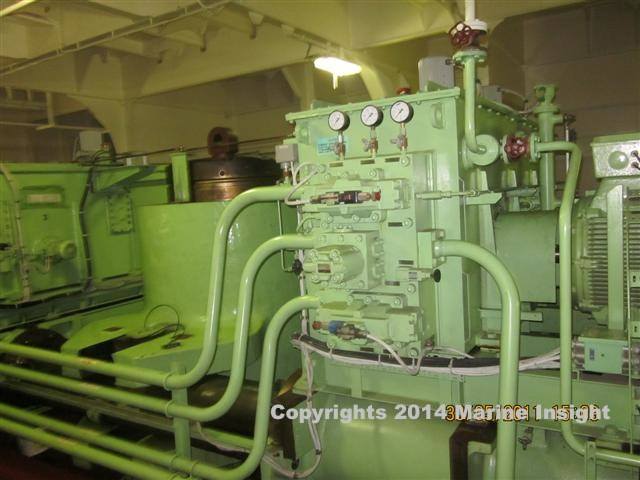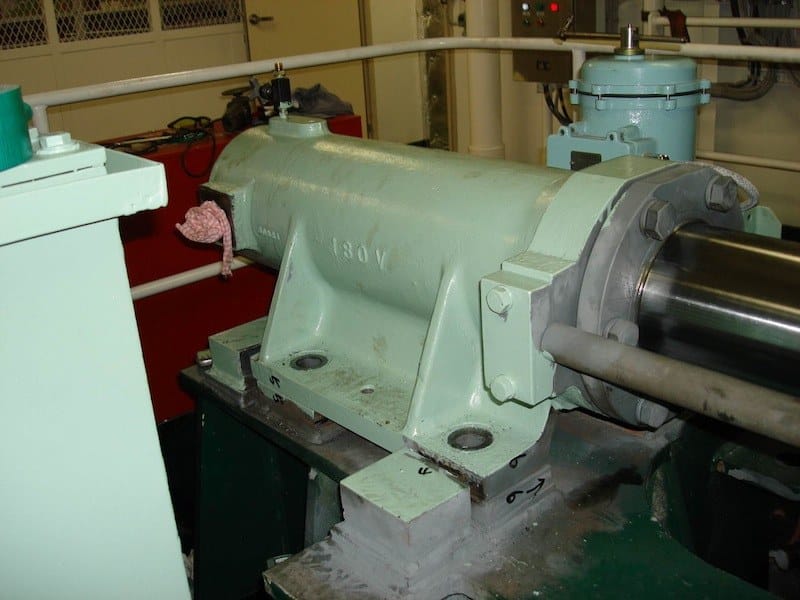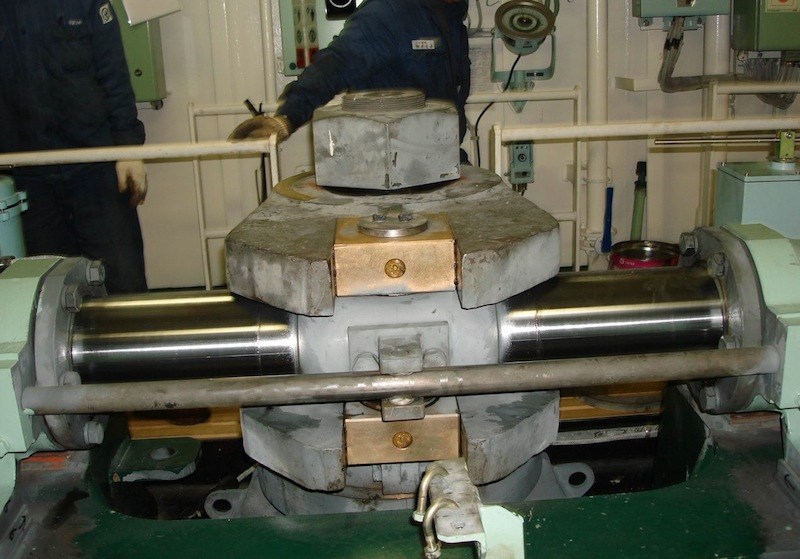8 Common Problems Found In Steering Gear System Of Ships
A vessel, under pilotage, departed a port in ballast and was down bound in a restricted waterway. The engine control was set to bridge control and a helmsman was using manual full follow-up (FFU) steering.
At one point a port alteration was requested; however, the rudder angle indicator showed 10 degrees to starboard. Several port and starboard helm inputs were attempted with the FFU but no rudder movement could be observed on the rudder angle indicator. The pilot then ordered the engine to be stopped and that the anchor be readied.
The Master arrived on the bridge just as the vessel was leaving the buoyed channel. He went directly to the steering stand and transferred the steering system actuator switch from the port system to starboard system. This action restored control to the steering but it was too late. The vessel ran aground at an estimated speed of 8 knots over the ground.
Accidents because of steering gear failure are common in the maritime industry. Such incidents have lead to some serious accidents in the part, causing heavy damage to ship, its crew and the environment.
Periodic maintenance and checks are extremely important for smooth functioning of ship’s steering gear. However, there are a few common issues which tend to occur in spite of taking all necessary precautions.
Mentioned below are eight such common issues of steering gear system:
1. Oil Leakages: Port state controls have very strict policy of zero leakage from ship’s steering gear. Many ships have been fined and detained due to such faults pointed out during port state control inspection. Still, oil leakage from the steering gear is one of the most common problems on ships – a result of machinery systems having several moving parts operated by hydraulic oil. Some of the main areas of leakages are cylinder-ram seal in hydraulic ram type steering gear and seal in the chambers of a rotary vane pump. Needless to say, any kind of leakage from steering gear system must be rectified immediately.
2. Difference in the Actual Rudder Angle and Ordered Helm Angle: Another common problem observed in steering gear system is the difference in the angle given at the helm and the actual rudder angle. This occurs due to wrong or insufficient adjustment of control and repeat back lever. To rectify this problem, the turn buckle attached to the rod of control and repeat back lever are to be precisely adjusted.
3. Unsatisfactory Steering : The fuel consumption of the ship greatly depends on the efficiency of steering gear operation. If the steering gear is operating unsatisfactory, it will lead to delay in the ETA of the ship and increase main engine fuel consumption. Common reason for this problem is malfunctioning of safety valves or by pass valves in the system. Any problem in the control and repeat back lever will also lead to unsatisfactory steering.
To solve this issue, safety and by pass valve operation are to be checked at regular intervals. If any problem is noted, same to be recited at the earliest.
For control and repeat back lever, the turn buckle attached to the rod of control and repeat back lever are to be precisely adjusted.
4. Excessive Noise from Steering Gear: Excessive noise and vibrations from the steering gear indicates entrapment of air in the system. Due to air bubbles in the oil, pumps and pipings are subjected to air hammer leading to vibration and heavy noise. Air must be removed from the system using vent valve provided in the cylinder and pump specially after the system is replenished with new oil. If the valve located in the oil supply tank of the steering gear is throttled or closed, it will again develop air bubbles in the system. Ensure that this valve is always open when the system is in operation.
5. High Oil Temperature: Oil is the operating media in the steering gear system. Any abnormality in the parameters of oil will lead to other operations related problems in the steering gear. If there is increase in the oil temperature, it will directly reduce the viscosity of the oil and hamper the steering operation. The most common cause of increase in oil temperature is low oil level in the system. Thus, ensure that low oil level alarm in the tank is working and replenish the oil when required.
6. Rudder Movement is Within or Beyond the Limit: The SOLAS requirement for steering gear says that the system must be capable of putting the rudder over from 35 deg on one side to 35 deg on the other side of the ship at its deepest seagoing draught and running at maximum ahead service speed. It may sometimes happen that the maximum angle reached by the rudder is less than prescribed or the rudder is overshooting the 35 degree angle mark.
One of the main reasons for this problem is malfunctioning of limit switch fitted on the repeat back unit or on the auto pilot. Replace the malfunctioned limit switch or adjust the limit switch to maximum prescribed rudder angle.
7. No Steering from Remote control: Their is always a provision of local maneuvering in the steering gear for emergency situation if the remote control operation fails. Some common reasons for failure of remove controls are :
- Break down of hydraulic pumps : Other hydraulic pump to be started in such cases
- Malfunction of transfer valve
- Malfunctioning of hydraulic by pass valve in the pump
- Oil leakage
- Problem in tele control system
8. Rudder Angle Transmitter and Tiller Link Failure: On 29 April 2011, the Panama registered bulk carrier Dumun grounded while departing the port of Gladstone, Queensland. Prior to the grounding, the ship’s steering appeared to have stop responding to bridge commands when the linkage between the tiller and rudder angle transmitter detached. The steering gear continued to operate normally, but the transmitter lost its input signal and, as a result, the bridge mounted rudder angle indicator stopped working. Such cases are rare but they do occur.
To avoid such accidents, ensure that the duty officer must take a round before every maneuvering or departure port to check all the linkages in the engine room.
These are some of the most common issues seen in steering gear system on board ships. Steering gear issues have also been caused due to electrical system failure, improper maintenance, collisions/ accidents etc.
Do you any other common problems associated with steering gear of ships? Let’s know in the comments below.
Do you have info to share with us ? Suggest a correction
Latest Marine Technology Articles You Would Like:
- 10 Harmful Effects Of Impure Air On Ship’s Machinery
- 10 Important Things to Check While Starting Fuel Oil Purifier on Ships
- 10 Noteworthy LNG-Powered Vessels
- 10 Points for Efficient Turbocharger Operation On Ships
- 10 Practical Tips to Handle Engine Room Pumps
- 10 Precautions to Take Before Operating Controllable Pitch Propeller (CPP) on Ships
Subscribe To Our Newsletters
By subscribing, you agree to our Privacy Policy and may receive occasional deal communications; you can unsubscribe anytime.
Web Stories

About Author
An ardent sailor and a techie, Anish Wankhede has voyaged on a number of ships as a marine engineer officer. He loves multitasking, networking, and troubleshooting. He is the one behind the unique creativity and aesthetics at Marine Insight.

























Thank you anish for giving me this much knowledge about the steering gear and also am studying in this field as an BSc Nautical Science. Knowing of this much things is so important to me itself. Thank you again.
Thank you for the above knowledge.. Looking forward to more things to learn from this page.
What is the limiting angle of the rudder movement and why is it limited to this value. and explain why leakage at pipe union results in oil loss in addition to air ingress
Please tell safety max. limit angle of rudder and reason of the limit.
Thanks
Explain how the following is achieved for ships electro hydraulic steering gear
Replenishment of hydraulic oil to make good losses caused by minor leakages from gland
Explain how the following is achieved for ships electro hydraulic steering gear
Replenishment of hydraulic oil to make good losses caused by minor leakages from gland
Please help me in this question
Thanks
please i want to know the answer to Alfred question
This question was already answered in our forum. Check- https://forums.marineinsight.com
Air Lock in the steering system… at point air lock can be released.
Hi sir/Madam.
I really want to know what is the main problem to one of ship that is not working the steering wheel when you turn it to starboard and board side, at the first time I repair the mother board and two other boards were still blown up same part. When I install them back after I fix it, it seems that those boards where working fine as the 4 led on the mother where light on but the steering wheel still not working until now.
There 3 main switch on the right hand of the steering wheel the another one is Solenoid 1, off switch, Solenoid 2, but right now were are working on solenoid 1.
Could you please answer my questions.
Thanks you
What is hydraulic locking in steering gear and what are reasons?
How to remove air from the telemotor system.What are the dangers of air in a telemotor system?
Dear Sir,
I had noticed one problem on my complete voyage.
Steering gear motor (port) frequently overload alarm activate. on making complete checks, i had changed TOR of same settings…later again overload alarm activated. this time i checked with motor insulation and its temperature. with motor it is also fine… what could be the prime problem
What is special about Steering gear Overload safety?
A large number of motors installed on the ship is provided with overload trip. Steering gear motor is not provided with any trip but only with overload alarm.
Here in Lagos, Nigeria, a 42,000 dwt oil tanker vessel built in 1990 was acquired from her former Owner. During ship trial at offshore anchorage, the rudder was not obeying bridge command, even though the rudder angle indicator corresponded with the steering wheel position. It was observed, and the radar showed it too, that the vessel was circling and almost hit an anchored vessel. When the steering gear system was later tried out it was discovered that the rotary vane steering gear motor responded to command, the rotor (rudder stock, marked at midships on the rotor gland cover) also responded accordingly but the rudder remained at about 2 deg. stbd (as observed from a boat), even as the rudder angle indicators showed 35 port or stbd. The rudder bearing is surely damaged. I can now conclude that it is the position of the rudder stock that is indicated on the rudder angle indicator and not that of the rudder. Generally, the linkage is between the tiller or steering motor (not the rudder blade) and the rudder angle transmitter.
Again, in a keyless connection between the rudder stock (rotor) and the steering gear (motor) in a rotary vane steering gear, slippage can occur, thereby allowing the rudder to turn to an angle different from that on the rudder angle indicators. Worse still, three different angle positions may result if the rudder bearing is damaged – the steering motor angle, the rudder stock angle and the rudder blade angle. Here also, the transmission linkage rod is connected between steering motor top side and the rudder angle transmitter, with no direct or remote connection to the rudder stock and the rudder blade. This is a serious challenge to Frydenbo and other rotary vane steering gear manufacturers in designing three transmitters that will indicate the steering motor angle, the rudder stock angle and the rudder blade angle, simultaneously.
@Ignatius Uba: Thank You Chief for sharing your experience with us. This will help fellow seafarer to understand what to do if they encounter a similar situation.
Dear Sir,
Steering gear system have bean Port side two hydro pump 1&2 running together we get 1#phase fail STG (Port) alarm comming ,please tell me problam thank
sir both steering hose having supply at the same time what might be the reason thanks in advance
Thanks, it’s beautiful
Hello sir, my tug boat rudder indicator was not obeying to stbd. But the angle follow the direction when the wheel was turn to port or midship. The direction at the indicator stuck at midship while the wheel is turn to stbd, rudder system and blade turn to stbd but the indicator is not. So what would i do to fix dis problem. VMT for ur corporation sir.
Hi dear
I have steering gear on board maker is porsgrunn n it’s running fine in autopilot mode n with nfu tiller but when doing steering with wheel that time it’s stop movement at mid ship for 6/7 seconds n than running fine. It’s happened always with wheel steering n giving command from stbd 30 degree to 30 degree port or either side. Pls advice
Thank you.